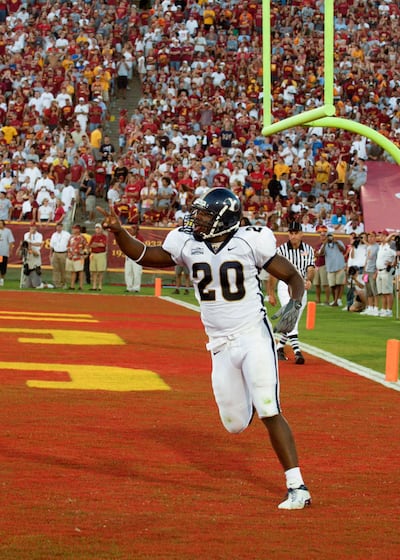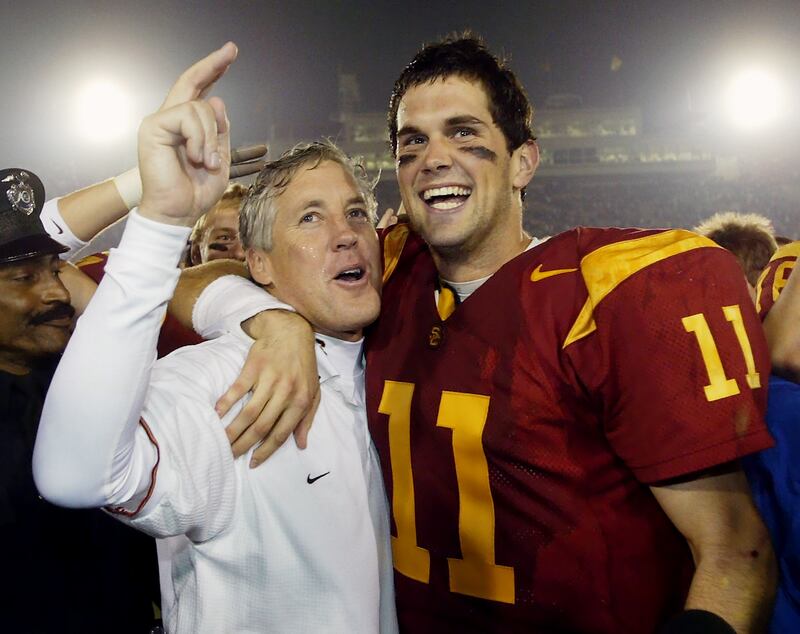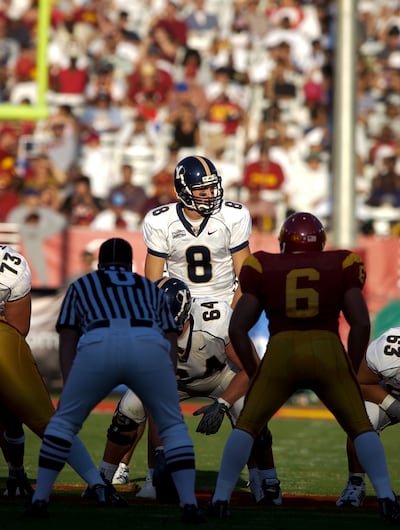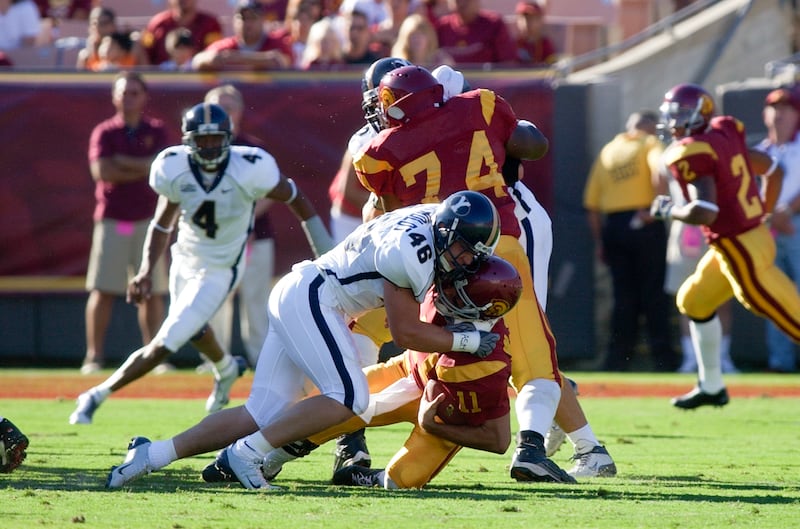The Goodyear Blimp hovered over the Los Angeles Memorial Coliseum on a 90-degree early September night that seemed a little too warm for football, but temperatures were soon forgotten a few minutes after kickoff.
Legendary college football announcer Keith Jackson was the play-by-play man for ABC television, and opened the broadcast with not only a tribute to USC’s glorious past, but BYU’s tradition of upset-producing quarterbacks such as Steve Young, Robbie Bosco and Ty Detmer.
The place was packed with 75,315 fans — about 20,000 of them decked out in the navy blue of BYU and subjected to the nosebleed seats behind one of the end zones.
And the grass was cut so short, and was so pristine, that several BYU players dropped to their knees and touched it with their hands to make sure it was really real.
“The first thing that comes to mind is that we missed an opportunity to make a really big statement. We were on a big stage, due to USC’s dominance in college football, and we were right there with a chance to pull off quite the upset, but too many mistakes doomed us to the loss.” — BYU receiver Chris Hale
Eighteen years after BYU made its first visit to Los Angeles to take on then-No. 4 USC in 2003 and lost 35-18 in a David vs. Goliath matchup that was truly much closer than the final score indicates, four Cougars who played in that contest shared their memories with the Deseret News, reliving the highs, lows and excitement they have played over and over in their minds.
“The first thing that comes to mind is that we missed an opportunity to make a really big statement,” said receiver Chris Hale, summing up the thoughts of quarterback Matt Berry, defensive end Brady Poppinga and cornerback Jernaro Gilford, a native Angeleno who is now the Cougars’ cornerbacks coach.
“We were on a big stage, due to USC’s dominance in college football, and we were right there with a chance to pull off quite the upset, but too many mistakes doomed us to the loss,” Hale said.
BYU will try again to beat L.A. in L.A., as it were, on Saturday under totally different circumstances.
In a turn of events absolutely no one saw coming when the season began, or even 18 years ago, No. 14 BYU (9-2) is favored by more than a touchdown to beat backsliding USC (4-6) at the Coliseum, sure to be less than full.
Kickoff is at 8:30 p.m. MST and the game with possible postseason bowl implications for BYU and nothing more than pride and bowl eligibility on the line for USC will be televised by ESPN.

Will history repeat itself, or will BYU improve to 5-0 against Pac-12 teams in 2021?
“It is expected that BYU will win pretty handily,” said Poppinga.
In other words, times have changed.
Of course, the Mountain West/independent Cougars and Pac-12’s Trojans have locked horns twice since that first-ever meeting of two of the more prominent football programs in the West, USC winning 42-10 in Provo the following year and Zach Wilson-led BYU winning 30-27 in overtime at LaVell Edwards Stadium in 2019.
This time, BYU fans almost assuredly won’t be outnumbered to the extent they were in 2003. Some folks believe the Cougars could have as many fans at Exposition Park as Senior Night-celebrating USC, if not more, given the way BYU fans have overtaken significantly smaller away venues during the Kalani Sitake era, the number of members of The Church of Jesus Christ of Latter-day Saints in Southern California, and the current fortunes of both programs.
“I wouldn’t be surprised if the majority of the crowd down there Saturday are cheering for BYU,” Berry said.
What in the name of Pete Carroll, Matt Leinart, Reggie Bush, LenDale White, Keary Colbert, Mike Williams and Hershel Dennis is going on here?
Those names should sound familiar to BYU fans, because those were the Carroll-coached Men of Troy who led USC to that 17-point win as 22-point favorites on Sept. 6, 2003. Leinart would go on to win the Heisman Trophy in 2004, and Bush won it in 2005 before it was later taken away by the NCAA because he and his family accepted impermissible benefits, including the rent-free use of a San Diego home.
“That USC team was absolutely loaded,” Gilford said.
In 2003, both teams entered the showdown 1-0, USC having shut out Auburn 23-0 to vault up the national rankings, and BYU having downed Georgia Tech 24-13 in head coach Gary Crowton’s third season-opener of a four-year stint in Provo.
USC would go on to a 12-1 record, losing only 34-31 to Cal in three overtimes in Berkeley. Not until the Trojans beat Michigan 28-14 in the Rose Bowl on Jan. 1, 2004, did a team come closer to USC in a losing cause than BYU on that memorable night near Hollywood.
“We expected it to be very hard, and it certainly didn’t disappoint us,” Carroll said after the game. The Cougars would finish the season 4-8, but on that steamy night in Tinseltown the preview turned out to be much better than the movie.
“BYU played a great game defensively (with defensive coordinator Bronco Mendenhall calling the plays) and it was tough to make adjustments against them,” Leinart told the Los Angeles Times. “But we did what we had to do. We won, and we will move on to next week.”
For BYU, which actually had more yards, 359-305, but committed three turnovers and a boatload of other mistakes, it was a case of what might have been, an opportunity lost. The Cougars fell behind 21-0 midway through the first quarter, pulled to within 21-18, but gave up two late touchdowns in the final four minutes to miss out on what would have been a monumental upset.

Berry, Poppinga, Hale and Gilford recently shared their memories of the 2003 game, along with what they think will happen on Saturday:
Starting quarterback Matt Berry
As one of the top 15 prep quarterbacks in the country coming out of Redmond, Washington, in 1999, the 6-foot-6 Berry was recruited by USC before choosing BYU, so the showdown with Leinart and the Trojans took on even more significance. Also, Berry’s father, Robert, played football for Stanford against USC in 1969 and 1970.
“It is like you are entering sacred grounds when you go in there, and you think of the history that has happened there, from the Olympics to all the great football games played there in 100 years or so, even more now,” Berry said.
The first thing he noticed was the grass, “sort of like a putting green,” and how different it was from the playing surface at venues in the Mountain West.
Also, USC’s offensive coordinator was Norm Chow, the same Norm Chow who had recruited Berry to BYU over the likes of USC, Washington, Stanford and Arizona State.
“So there was that dynamic for me,” Berry said. “USC was certainly on the upswing at the time, but they weren’t quite the perennial power that they would become in subsequent years in the Pete Carroll-Norm Chow era.”

Leinart redshirted in 2001, and was Heisman Trophy winner Carson Palmer’s understudy in 2002, so he wasn’t yet a household name in 2003, having beaten out Matt Cassel and John David Booty for the starting spot by the slimmest of margins.
“I didn’t see it as a me vs. him thing,” Berry said. “We didn’t really know who Matt Leinart was at the time.”
Berry completed 27 of 39 passes for 297 yards and a touchdown, but threw three costly interceptions; one was returned by USC defensive end Omar Nazel for a pick-six to give the Trojans the 21-0 lead with two minutes, 34 seconds remaining in the first quarter.
Leinart was 19-for-34 for 235 yards, but was sacked for a safety by K.C. Bills and intercepted three times — by John Denney, Josh Brandon and Poppinga.
Berry remembers several questionable calls by the officials that went USC’s way, but college football did not begin using video replay reviews until 2005.
Receiver Rod Wilkerson was ruled out of bounds on an end-zone catch, and running back Fahu Tahi lost a fumble in the fourth quarter when the Cougars swear his knee was down.
“Probably speculating a bit too much, but if they had the replay process, I believe those calls would have gone in our favor,” Berry said. “It was one of those games that certainly you wish you could go back and play again, and if a couple things had gone our way, we would have come out ahead.”
“It is like you are entering sacred grounds when you go in there, and you think of the history that has happened there, from the Olympics to all the great football games played there in 100 years or so, even more now.” — BYU quarterback Matt Berry
The following week, Berry suffered a fractured right hand in the 10-7 win over New Mexico, and he was never the same again. “
“To this day, I still can’t make a full fist,” he said. “That is how devastating that break was.”
Berry graduated from BYU in 2005 and co-founded a healthcare technology company, Orca Health, in 2012 that is currently thriving. He lives in Sandy with his wife, a former Cougarette, and three daughters, and still follows the program closely and attends most home games.
“I could have transferred (when John Beck got the starting nod in 2004 when Berry returned from the injury), but I was very happy at BYU, and felt very loyal to the university even though my career didn’t go as planned, or as I wanted it to,” he said. “I have never regretted not transferring, or not leaving.”
Starting defensive end Brady Poppinga
Poppinga’s most vivid memory of the game 18 years ago — before he concluded a four-year starting career at BYU in 2004 and was selected in the fourth round of the 2005 NFL draft — was going up against the likes of the aforementioned Leinart, Bush, Colbert and Williams and holding his own.
“They had no idea how to stop our defense,” Poppinga said. “After basically handing them 21 points (one was a defensive score), we had overwhelmed them to the point where I didn’t think they were that good, because we shut everything down. So that was my best memory.”
Poppinga sacked Leinart once, picked him off once, and had six tackles; his senior season, 2004, he moved to outside linebacker.
“We got down early, but we came back and put a scare into them,” he said. “They ended up scoring 35, but we felt like we stifled them pretty well. They got some cheap touchdowns, but throughout the majority of the game they were very, very stifled. It was a fun game, other than the outcome didn’t go in our favor.”
Having played in the NFL for eight seasons with the Packers, Rams and Cowboys, Poppinga owns a fitness equipment business and Customized Fitness Solutions. He invented the XPT Trainer.
Poppinga said the 2003 BYU football team was confident and had great leadership, so players weren’t intimidated by being on national television, playing in the Coliseum, or facing all the great athletes that USC had across the field.
“We were just excited about the opportunity, like BYU’s teams always have been. We felt like we were Power Five — or at that time, BCS-caliber players, so the thought was, ‘Let’s go prove it to these top-tier players,’ and I think we did.” — BYU defensive end Brady Poppinga
“We were just excited about the opportunity, like BYU’s teams always have been. We felt like we were Power Five — or at that time, BCS-caliber players, so the thought was, ‘Let’s go prove it to these top-tier players,’ and I think we did,” Poppinga said.
He remembers that some teammates “felt like underdogs, like a David vs. Goliath scenario, that we had to somehow pull something out that would be very, very difficult to do.”
Poppinga said he remembers the USC crowd being taken aback a bit by the number of BYU fans in attendance, and how a “blue wedge” of thousands of fans in one particular corner was particularly loud and supportive.
“You have to remember that USC was rolling in that era. Carson Palmer had just won the Heisman, and it was packed with USC fans,” Poppinga said. “So BYU was very well represented, but it wasn’t like there was this parity between fan bases. When BYU made a play back then, there was a good amount of applause, but nothing like when the home team made a play.”
Poppinga said it will be different this Saturday, “because USC fans have a high standard of excellence and they probably aren’t going to support something they don’ feel like is excellent — which this USC team is not.”
Of course, Poppinga’s brother, Kelly, also played at BYU and is now a co-defensive coordinator under Mendenhall at Virginia.
“I would anticipate with all the excitement surrounding BYU football right now, and BYU sports in general, that you are going to see a lot of BYU fans there Saturday,” Brady Poppinga said. “There are so many people in Southern California that care about BYU football now, it is going to be packed with BYU fans, probably like it has never been on the road, at a place like USC or UCLA.”
Backup receiver Chris Hale
Like Berry, Hale said the first thing that struck him when he entered the Coliseum that day was the playing surface.
“It is like golf-course type grass, really short,” he said. “Not like in Provo, and other places we had been, where I think they grow the grass long on purpose” to slow down faster teams.
Hale said the Cougars weren’t intimidated by the Trojans, but were definitely in awe or their surroundings.
“You are like, ‘Wow, this is the Coliseum.’ Then you hear the familiar USC fight song from the band and you see the Trojan and the white horse and the crowd gets into it and you realize you are in a pretty cool place,” he said.
It was Hale’s first road game since returning from a church mission, and the butterflies were churning in his stomach.
“It was another reawakening into college football for me,” he said. “It was on ABC, nationally televised. I was probably more distracted than I should have been going into the game.”
The son of former BYU athletic director Val Hale, Chris Hale caught three passes for 20 yards in a game that he says he remembers like it was yesterday. He said BYU’s defense played well enough against all those USC superstars for the Cougars to pull off the win, but the offense committed too many costly mistakes.
“If I remember right, it was Bronco’s first year as a defensive coordinator and I think our defense really wreaked havoc with what they were doing,” Hale said. “They couldn’t tell where we were coming from. It was our miscues on offense that really gave them the momentum they needed to win.”
The Orem High grad also remembers the blown calls when the Cougars were on the comeback trail.
“We clawed our way back to within three points, and when Rod Wilkerson caught a pass in the back of the end zone, we thought we had scored to take the lead. But they said his pinkie toe was out of bounds. To this day, I still think that was a touchdown.”
As for the crowd, Hale says that when BYU was making its big comeback, it almost sounded as if there were as many Cougar fans there as Trojan fans.
“I just remember all the BYU fans were stuck up at the top,” he said, laughing.
Bush had just six rushes for 19 yards, but in 2004 the future Heisman winner would really shine against the Cougars in Provo, rushing for 124 yards and a touchdown and catching four passes for 42 yards and a TD in front of 63,467 in Provo.
“Personally, in 2004 I was on the kickoff team and he returned a kick, and for the first time in my life I felt like there no chance. He beat me to the corner. I had the angle on him. I was like, ‘holy smokes, who is this guy?” Hale said.
Starting cornerback Jerano Gilford
Growing up about 10 miles from the Coliseum, and playing at Westchester High in Los Angeles, Gilford dreamed of playing in the venue, which always seemed “larger than life” to him and his friends. When he got the chance, he made the most of it.
“I remember it was just a homecoming for me, a dream come true,” he said. “I remember looking across the field and seeing a lot of my friends on that opposite sideline. So that was really cool.”
Gilford had three tackles and a pass breakup.
“We played them pretty tough, probably surprised them a little,” he said. “Bronco was our defensive coordinator and I remember him on the sidelines saying, ‘Stay calm, just relax and do what we do.’ They were confused on offense — they jumped on us early, but we fought back. We had a chance to shock the world, but we fell short.”
Gilford still keeps in touch with the aforementioned Keary Colbert, now USC’s wide receivers coach.
“Man, with guys like Reggie Bush, LenDale White, Dennis Hershel, Steve Smith and my guy Keary Colbert, they just had great players everywhere you looked.” — BYU cornerback Jernaro Gilford
“They were loaded with athletes and they had stud offensive linemen, but we slowed them down,” Gilford said. “Man, with guys like Reggie Bush, LenDale White, Dennis Hershel, Steve Smith and my guy Keary Colbert, they just had great players everywhere you looked.”
That BYU defense had some players who would also go on to play in the NFL, guys such as safety Aaron Francisco, defensive tackles Poppinga and John Denney and linebackers Colby Bockwoldt, David Nixon and Mike Tanner.
Defensive speedsters like Gilford and Nate Soelberg kept the Trojans from making big plays.
“We gave them too many short fields,” Gilford said.
What will it be like to go back for the first time, but as a coach?
“It is not going to be the same, because of course I am not playing,” he said. “But I will probably have 100 friends and family there. I will probably need 100 tickets, literally. My mom still lives in the same house, which is not even 10 miles from the stadium. For me, that is home.”
It is just that 18 years later, it might feel like that even more for the BYU Cougars.


